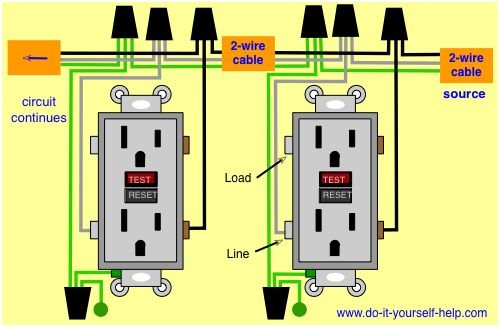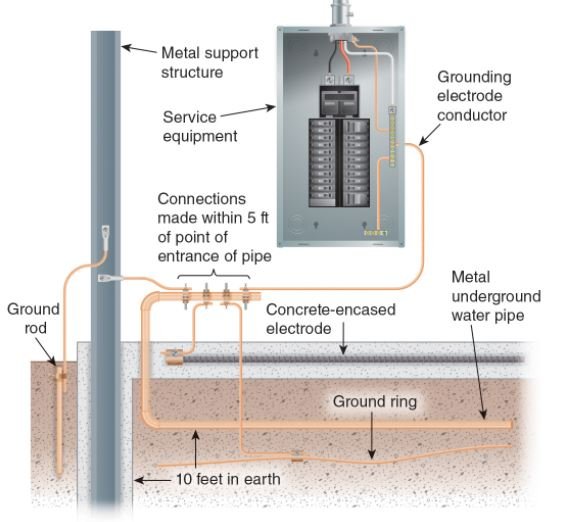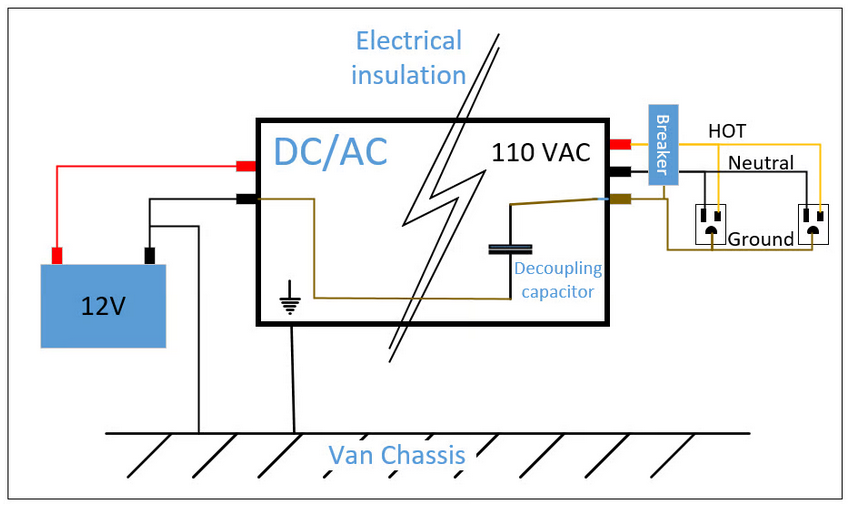Safety is extremely important in electrical installations, especially for off-grid solar homes. In this article we analyze design parameters for off-grid. We will list some of the protection devices and safety gear used in these types of installations:
Protection & Safety Devices
Protection & safety devices are installed to protect users and appliances at home. These are some of the most important protection devices used in an off-grid solar residential installation.
Ground Fault Circuit Interrupters (GFCI):
GFCI devices protect users against ground-fault electrocutions in off-grid solar PV systems. They also protect wiring against overheating or destruction of wire insulation. GFCI circuit breakers are popular for residential installations, but GFCI outlets are also valuable options for RVs.

GFCI outlets are connected on the AC side of the system, right before the appliances. These devices require a hot, neutral, and ground wire connection. A GFCI outlet compares input vs. output current, tripping the safety system if there is a current difference of 6 mA – 30 mA (depending on the manufacturer).
For personal protection, the rating used is 6mA, while for equipment protection, the rating used is 30mA in the US.
A GFCI breaker can also be installed at the main source of branch circuits to provide both overcurrent and grounding protection. This is particularly best for high-power demand applications (such as a dryer or hair dryer) and in locations where people may need to be in contact with water (bathrooms for instance).

In Europe, the GFCI is located in the main switchboard. One for wet circuits (bathroom, garden, pool,…) and one for dry circuits (all the rest).
When selecting a GFCI, it is important to consider the current tripping sensor rating (generally 6mA), the nominal current (according to the expected normal load), the class rating (generally type A, B or C) and the voltage (according to the supply, normally 240VAC for split systems)
Residual Current Device (RCD) & Residual Voltage Device (RVD)
RCDs and RVDs are protection devices measuring current, or voltage unbalances (respectively) that protect living beings from touching bare wires or non-insulated equipment. They are essentially the same as GFCI but designed according to IEC standards.
An RCD is used in residential off-grid solar PV systems with solid electrical grounding. While less known, RVDs can be used with RCDs when a solid electrical grounding system is not possible where RCDs are less reliable.

RCDs operate by tripping the protection at a current threshold of 30 mA or less, providing electrical safety against electrocution. Similarly, RVDs trip at a voltage unbalance superior to 43 volts, simultaneously protecting appliances and living beings. While these devices are not specifically required in RVs, they provide additional protection that is worth it.
These devices are installed after the solar inverter in the off-grid PV system, operating with 120V or 240V systems and are connected to the main AC supply acting as a general switch.
Similar to GFCI, it is important to consider the current tripping sensor rating (generally 30mA or lower), the nominal current (according to the expected normal load), the curve type (type A, B or AC) and the voltage (according to the supply, normally 240VAC for split systems)
Earthing or electrical grounding

Earthing or electrical grounding is a protection system setting a 0-volt reference point with a low impedance, working as a return path for faulty electricity during overloads and faulty wiring. Residential off-grid PV systems are grounded by placing a grounding electrode a few feet below the earth.

RVs cannot be grounded to a soil, which is why the chassis, starter motor, or engine block can be used as a grounding alternative. RV grounding occurs on the DC side, right after the battery and connected to the negative terminal of the battery (Figure 4). It is important to keep in mind that solar panels must also be grounded to this system.
This grounding method is not as safe reference as proper earthing performed in homes, however it is the best solution and currently the standard of the industry.
Solar isolator switch
A solar isolator switch is an important device to incorporate into your system between the solar array and the charge controller. This needs to be a DC breaker rated at 32A or 63Amps. Read more about it here.
Safety Gear
It is always important to use safety gear when performing electrical repairs or installations. These are some of the most important electrical safety gear equipment:
- Leather gloves.
- Hard hat.
- Arc-rated pants.
- Face shield.
- Long-sleeved shirt.
 I have written a book that contains all the information you need to get started with off-grid solar power.
I have written a book that contains all the information you need to get started with off-grid solar power.
With over 1,800 reviews at 4.5 stars, I can almost guarantee that this book will save you $100s on buying the right equipment.
You can get it here on Amazon.com

I’m an off-grid enthusiast. I created this website to give clear and straight-to-the-point advice about solar power. I’m also the author of the book ‘Off-grid solar power simplified‘. Read more about me on my about page, check out my Youtube channel, or send me a message.
Hi Nick,
I found your page looking for a solution for our new Off Grid Solar installation and even though it’s a bit off topic from this exact page, I hope you could shed a light on our issue.
What we would like to install on our 24v installation is a hierarchy, a cascade of relays that would switch off circuits with non vital high consumers at a certain battery level, keeping circuits open for more vital consumers (fridge and lights mainly). We would have the ultimate battery protection set on our inverter (victron, has the function built in). We would like to switch off completely at 24.2volt. But switch off a first circuit at 25volt to go in energy saving mode and another circuit at 24.6volt to go to fridge and lights mode only.
Do you happen to have schematics for this, is it mentioned in the book (we would buy it then), are there off the shelve solutions?
Would greatly appreciate your experience,
Have a great one,
Steven
Hello Steven,
I don’t have a schematic like that in the book. However, I think you already answered your question, you can use a battery protect to shut the circuit down.
However, I never heard about anybody doing this. You can send me an email and I gladly help to design the system with you.
Btw, are you Begian? Your name sounds like it.